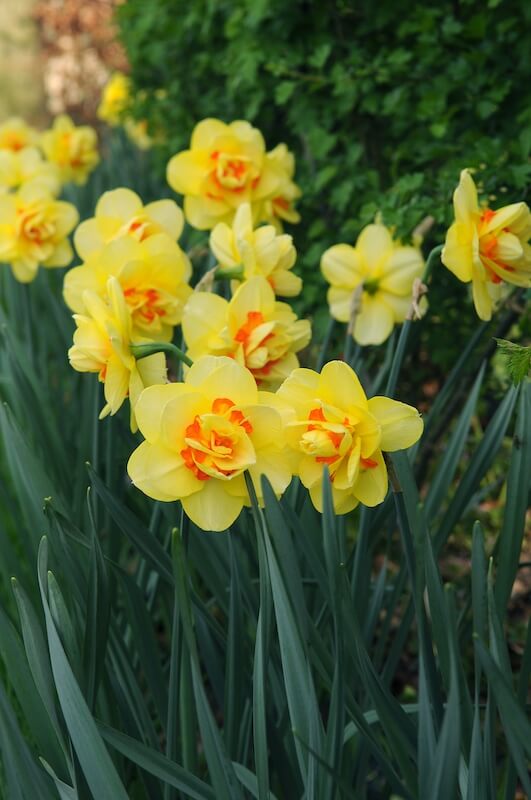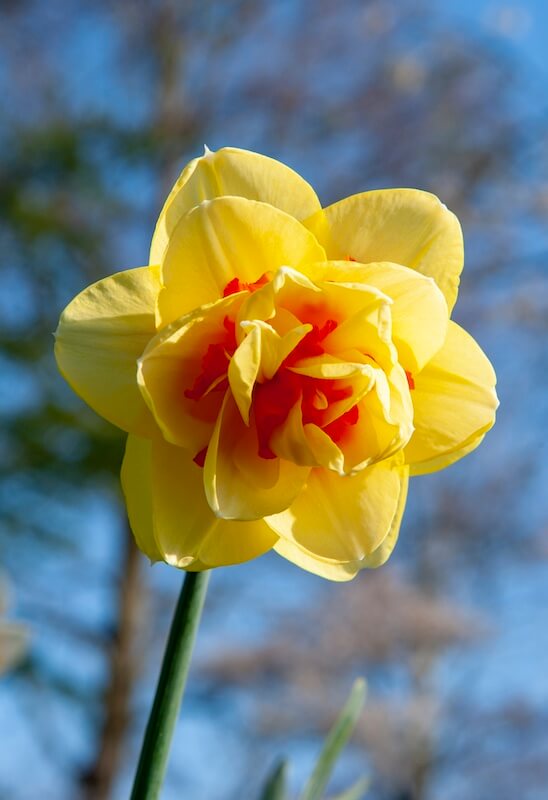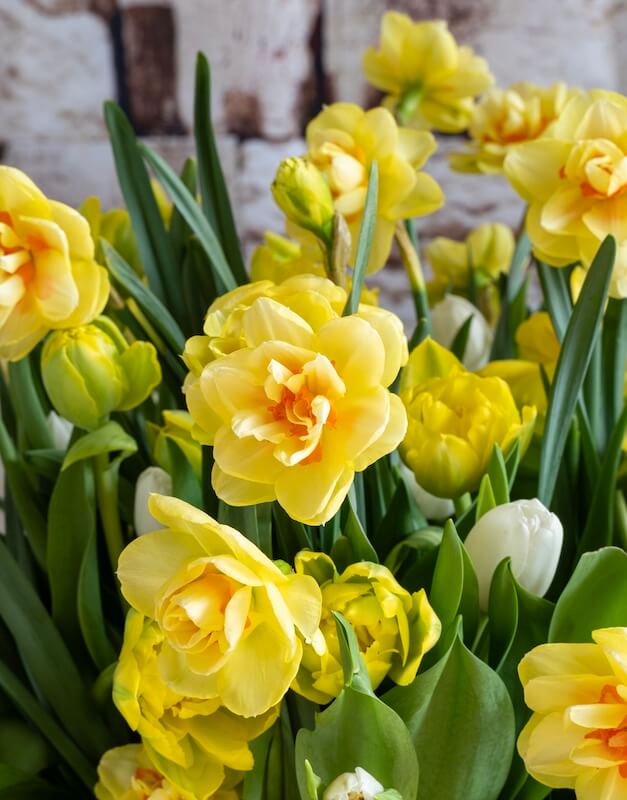
Position
- Full sun to light shade; best flowering in a sunny spot
- Prefers a sheltered site away from cold, drying winds
- Equally effective in borders, gravel beds or large containers
Hardiness
- Withstands winter lows down to approximately –20 °C (–4 °F)
- A light mulch over the bulb row in late autumn helps in very exposed gardens
Soil
- Thrives in fertile, well-drained soils such as loam or sandy loam
- Incorporate plenty of garden compost or well-rotted manure for improvement at planting
- Avoid heavy, waterlogged clay, which can rot bulbs
- Adapts to acid, neutral or alkaline soils
- Performs best where organic matter maintains good structure and moisture without waterlogging
- Grab a soil test kit and ensure the perfect conditions for growth
Height
- Clumps establish over time and flower at about 30–40 cm (12–16 in) tall each spring
Seasons of Interest
Additional Notes
- Plant bulbs in autumn, 12–15 cm deep and 10–12 cm apart, in groups for best impact
- Leave foliage until it yellows fully before cutting back to allow bulbs to replenish energy
- Divide and re-plant congested clumps every 3–4 years once leaves have died down
- Deadhead spent flowers to keep the display tidy and direct energy back into the bulb
- All parts are mildly toxic; handle bulbs with gloves and keep away from pets and children
- Suitable for naturalising in grass—lift and replant turf after flowering to avoid damage
Narcissus Tahiti - A Burst of Golden-Yellow Double Blooms
Few spring-flowering bulbs offer such bold beauty as the Narcissus Tahiti. This double daffodil has earned admiration from gardeners across the UK for its distinctive two-tone effect, abundant blooms, and reliable growth. Narcissus Tahiti is not only a striking addition to borders but also an excellent choice for containers, pots, and even cut flower arrangements.
What makes Narcissus Tahiti different from other daffodils?
Narcissus Tahiti is famous for its beautiful double-flowered form. Unlike simple daffodils with a single trumpet, this cultivar boasts layer upon layer of golden-yellow petals. At the centre, ruffled segments of deep orange create a distinctive two-tone effect that ensures every flowerhead can grow into a dramatic highlight of the garden.
Standing at around 40cm in height, these double flowers are tall enough to make a statement in borders yet compact enough for pots and containers. The sturdy stem carries the weight of the bloom, which can often be larger than standard daffodils. With its double blooms, Narcissus Tahiti commands attention in every planting scheme.
It’s also versatile. Whether used as cut flowers, grouped in beds, or mixed with other spring bulbs, it brings an eye-catching and vibrant display. The combination of golden yellow petals with deep orange ruffles creates unmatched colour in a spring garden.
When is the best time for planting Narcissus Tahiti bulbs?
The ideal time for planting daffodil bulbs such as Tahiti is autumn. Planting in this season gives bulbs time to develop roots before winter sets in. Aim to plant in groups for a natural, colourful display that brightens borders and containers alike.
Bulbs should be planted at a depth of around 10–15cm (4–6in). As a general rule, plant 10-15cm deep, about three times the bulb’s height. Space bulbs a few centimetres apart to allow enough room for growth. Plant in groups rather than single lines, as clusters of blooms create far more impact in the spring garden.
If the soil is heavy, improve it with compost or grit to create well-drained soil. This ensures bulbs won’t rot during wet winter months and promotes strong flowering in spring. By planting in autumn, you’ll enjoy vigorous growth and an early display of vibrant flowers when spring arrives.

What type of soil and light does Narcissus Tahiti prefer?
Like most spring-flowering bulbs, Narcissus Tahiti thrives in well-drained soil. Bulbs are prone to rot if waterlogged, so improving drainage is key. If you have clay soil, add grit or organic matter before planting. For sandy soil, enriching it with compost helps retain moisture.
Full sun provides the best conditions for bloom production. These double daffodil bulbs can tolerate partial shade, but flowers will be stronger and colours more vibrant in sunny locations. A spot that receives at least six hours of light daily ensures lush foliage and strong stems.
Keeping soil moist during the growing season is essential, but avoid waterlogging. Once established, bulbs are low-maintenance, needing only minimal care between flowering periods.

How do you plant daffodil bulbs in pots and containers?
Narcissus Tahiti is ideal for pots, patio containers, and even small garden spaces. Planting daffodil bulbs in pots lets you move the flowers closer to doors, paths, or seating areas where their colour can be thoroughly enjoyed.
Choose a container deep enough to allow for 10–15cm planting depth. Use a high-quality, peat-free compost that drains well. Plant bulbs close together, leaving just enough space so they don’t touch. This creates a dense cluster of blooms that looks striking in spring.
Keep the compost moist during the growing season, but ensure excess water drains away. Place the container in full sun for the best display. After flowering, allow foliage to die back naturally before lifting bulbs or leaving them in the pot for next year.
How does Narcissus Tahiti perform in borders and spring gardens?
In the garden border, Narcissus Tahiti is unbeatable for early-season drama. Planting in groups along the front or middle of borders creates swathes of colour when the rest of the garden is still bare. The golden-yellow petals stand out brilliantly against green foliage and the soft tones of other spring bulbs.
This cultivar reaches a height of around 40cm, making it ideal for mixed borders. It holds its flowers high enough to be noticed without overshadowing smaller spring plants. Its sturdy stems resist wind and rain, keeping blooms fresh and upright.
In a spring garden, these daffodil bulbs shine when combined with tulips, hyacinths, or muscari. The distinctive two-tone effect of Tahiti’s petals contrasts beautifully with blues and purples, making borders vibrant and dynamic.
What is special about the double flowers of daffodil Tahiti?
The double blooms of daffodil Tahiti set it apart. Each flower features golden-yellow petals layered around the centre. Ruffle-like orange segments fill the middle, giving a complete, lush look. This distinctive double-flowered form creates an eye-catching focal point.
Unlike single blooms, double daffodils deliver an extra show. Each flowerhead can grow to an impressive size, and with the distinctive two-tone effect, they add depth and texture to displays. The golden yellow petals paired with fiery orange centres are unlike any other daffodil cultivar.
These flowers also make excellent cut flower arrangements. Their long stems and double blooms last well in vases, bringing spring indoors. The colour combination is both vibrant and sophisticated, making it perfect for seasonal displays.
How should you care for Narcissus Tahiti after flowering?
After flowering, allow the foliage to die back naturally. This ensures the bulb stores enough energy for the following year. Cutting foliage too early weakens the bulb, so always let leaves yellow before removing them.
Deadhead faded flowers to stop seed production and direct energy back into the bulb. This simple step helps bulbs recover faster and ensures stronger blooms the following spring.
Over time, clumps of daffodil bulbs may become crowded. Lift and divide them every few years in late summer or early autumn to refresh your display. This keeps plants vigorous and ensures a consistent, colourful show each spring.
Why is Narcissus Tahiti considered a reliable perennial?
Narcissus Tahiti is a perennial bulb, meaning it returns year after year without the need for replanting. Once planted in the right conditions, bulbs naturalise and gradually spread, creating more flowers over time.
This cultivar is valued for its strong growth and dependable flowering. With proper care, including allowing foliage to die back naturally, it remains productive for many years. For gardeners, this means long-term value from a single planting session.
As a perennial, Narcissus Tahiti is both easy to grow and low-maintenance. It requires little beyond good soil, sunshine, and the patience to let leaves recharge the bulb each season.
How tall do double daffodil bulbs like Tahiti grow?
Narcissus Tahiti typically grows to a height of around 40cm. This size makes it perfect for mixed borders and containers. At this height, the plant balances visibility and stability.
Each sturdy stem carries a large, double flowerhead. Because each flowerhead can grow large, the stem needs strength, and Tahiti provides it. The tall yet steady growth habit ensures blooms don’t flop or break in spring weather.
The combination of a manageable height with vibrant double blooms makes Narcissus Tahiti one of the most popular spring-flowering bulbs. It bridges the gap between compact miniature varieties and tall, trumpet daffodils.
What makes Narcissus Tahiti an eye-catching addition to spring gardens?
Narcissus Tahiti stands out because of its vibrant colour and distinctive flower shape. The golden-yellow petals with ruffled orange centres create an unmatched, eye-catching effect.
In the spring garden, when colour is often scarce, these blooms provide instant vibrancy. Their double blooms ensure displays look full and lush, while their height and strong stems keep them prominent in borders and pots.
As part of a mixed planting scheme, daffodil Tahiti provides a beautiful contrast to blue muscari, pink tulips, and white hyacinths. The result is a spring garden that feels alive, colourful, and ready to welcome warmer days.
Why should gardeners choose double daffodil bulbs like Tahiti?
Double daffodil bulbs bring extra value, delivering blooms that feel luxurious and distinctive compared to standard varieties. The beautiful double-flowered form adds texture, depth, and drama to the garden.
Narcissus Tahiti in particular combines reliability with beauty. Its distinctive two-tone effect is unlike other daffodils, ensuring displays are both vibrant and memorable. Whether you’re planting in borders, pots, or using them as cut flowers, these bulbs never disappoint.
For gardeners looking for spring-flowering bulbs that are easy to grow, perennial, and consistently eye-catching, Narcissus Tahiti is a perfect choice. Plant them once in autumn, and enjoy their colour and joy for years to come.
From Darren’s Patch
Nothing lifts the spring border quite like Narcissus Tahiti. I plant generous drifts for an instant splash of golden colour each April. The double blooms and ruffled centre give real garden theatre, yet the plants remain tidy and dependable. I also pot them in deep containers by the front door, where their dramatic flowers greet visitors and earn compliments. After flowering, I deadhead spent blooms and let the foliage die back naturally, then feed lightly to help bulbs recover. For cutting, Tahiti never fails to impress in a vase. In short, it offers big visual rewards for little fuss, and I recommend it to anyone seeking a reliable, showy double daffodil for borders, containers or seasonal bouquets.
![]()
Key Points to Remember
- Plant daffodil bulbs in autumn, 10–15cm deep (4–6in), for best results
- Choose a sunny spot with well-drained soil for strong growth
- Plant in groups for maximum colour and impact
- Narcissus Tahiti grows to a height of 40cm with sturdy stems
- Flowers feature golden-yellow petals with orange ruffled centres
- Each flowerhead can grow large, creating vibrant displays
- Allow foliage to die back naturally to recharge the bulb
- Works well in borders, pots, and containers
- Excellent as a cut flower, lasting well indoors
- A perennial bulb that naturalises and returns every year
Narcissus Tahiti brings bold, late-spring colour on sturdy 30–40 cm stems in UK gardens. With full sun, well-drained, improved soil and simple autumn planting, it naturalises beautifully and rewards you each April–May with its distinctive, rich blooms.
Want to learn about other bulb varieties? Read about Narcissus Tete a Tete here.
For more information on Spring Flowering Bulbs for your garden, please click here.

Frequently Asked Questions
Q: What is a Narcissus Tahiti?
A: Narcissus Tahiti is a stunning double daffodil known for its beautiful double-flowered form and distinctive two-tone effect. The vibrant golden-yellow petals surround a darker, ruffled centre, creating an eye-catching display in spring gardens. Typically reaching a height of 40cm, these spring-flowering bulbs provide both colour and texture in borders, containers, and cut flower arrangements. As a perennial, daffodil Tahiti blooms reliably year after year if planted in well-drained soil and full sun, and allowed to die back naturally after flowering to store energy for the next season.
Q: When should I plant daffodil bulbs?
A: The ideal time for planting daffodil bulbs is in autumn, when the soil is cool but not frozen. Planting in groups of 4-6 inches apart enhances the visual impact of spring blooms. Ensure bulbs are positioned in well-drained soil to prevent rot, and plant to a depth of 10-15cm. Double daffodil bulbs, such as narcissus tahiti, benefit from autumn planting to establish strong roots before winter. Feeding bulbs lightly at planting can promote vigorous spring flowering, producing vibrant, golden-yellow petals and robust stems. Proper autumn planting sets the stage for a flourishing spring garden.
Q: How do I care for Narcissus Tahiti in my garden?
A: After planting, Narcissus Tahiti requires minimal care but thrives with occasional feeding. Water the bulbs during dry periods and ensure they are in full sun or partial shade. Once flowers fade, allow the foliage to die back naturally; this process nourishes the bulb for the following season. Deadheading spent blooms can improve the plant’s appearance, but avoid cutting foliage prematurely. Planting daffodil bulbs in groups within borders, containers, or pots enhances their visual appeal and ensures vibrant double blooms with golden-yellow petals and a distinctive centre each spring.
Q: Can Narcissus Tahiti be grown in containers or pots?
A: Yes, Narcissus Tahiti thrives in containers and pots, making it ideal for patios, balconies, and small gardens. Use well-drained soil and ensure bulbs are planted to a depth of 10-15cm with sufficient spacing to allow air circulation. Containers should be placed in full sun to encourage strong stems and vibrant blooms. Feeding bulbs lightly can enhance flowering, while watering during dry periods keeps bulbs healthy. Plant in groups for an eye-catching display of double daffodils, with golden-yellow petals and ruffled centres that bring life and colour to spring gardens.
Q: Where can I purchase Narcissus Tahiti or double daffodil bulbs?
A: Narcissus Tahiti and other double daffodil bulbs are widely available from garden centres and reputable online suppliers. Choosing bulbs from trusted sources ensures high-quality, healthy stock that is ready for planting. Purchasing in autumn provides the best selection and allows bulbs to establish roots before winter. Selecting quality bulbs guarantees vibrant spring blooms, with beautiful double flowers and golden-yellow petals that enhance borders, containers, and cut flower arrangements.
Q: How should I plant double daffodil bulbs for best results?
A: Plant double daffodil bulbs, including narcissus tahiti, in well-drained soil during autumn, ensuring a depth of 10-15cm. Position bulbs 4-6in apart, ideally in groups, to create an impactful display of vibrant double blooms. Full sun or partial shade encourages strong stems and healthy foliage. Water thoroughly after planting, and feed lightly to promote vigorous flowering. Allow the foliage to die back naturally after flowering to nourish the bulbs for future seasons. With these techniques, double daffodil bulbs will produce eye-catching flowerheads with golden-yellow petals and a beautiful ruffled centre each spring.
Q: How tall do Narcissus Tahiti flowers grow?
A: Narcissus Tahiti typically reaches a height of 40cm, making it suitable for borders, containers, and mixed spring gardens. The flowerhead can grow on sturdy stems, displaying vibrant golden-yellow petals surrounding a distinctive, ruffled centre. Planting bulbs in groups enhances their visual impact, providing a bright, eye-catching display in early spring. Adequate sunlight, well-drained soil, and proper feeding contribute to strong growth, while allowing foliage to die back naturally ensures healthy bulbs for future seasons. These characteristics make daffodil Tahiti a standout choice for creating striking spring flowering bulb arrangements.
